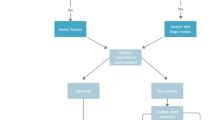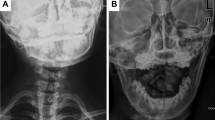Abstract
Objective
To analyze the varied presentation and management of atlas assimilation with associated radiographic abnormalities in children in the MRI era
Methods
Database analysis of 313 children (less than 10 years)
Results
Atlas assimilation (AA) was associated with atlantoaxial dislocation in 12, abnormal skull base and Chiari I abnormality in 42, C2-C3 segmentation failure and instability and Chiari I abnormality in 74, and condylar hypoplasia and basilar invagination in 74. Proatlas segmentation failures were 54, atlantoaxial rotary dislocation in 26 with Goldenhar’s syndrome, abnormal C1 atlas posterior arch causing dynamic compression of cord in 31 children. Vascular compromise was documented in 26 children. The study encompassed ages 6 months to 10 years. Cranial nerves commonly affected were glossopharyngeal, vagal, and hypoglossal nerves. Children below 2 years presented with torticollis, failure to thrive, difficulty swallowing, and motor and sensory deficits.
Craniovertebral junction instability associated with AA was treated with custom-built craniocervical orthosis below 5 years. Closed reduction of instability or basilar invagination was attempted with neuromuscular blockade under anesthesia and traction above age 5 years. Successful reduction was treated with dorsal foramen magnum and atlas decompression with occiput-C2 dorsal fusion using rib grafts below the age of 5 years and instrumentation after that.
Follow-up was 2 to 32 years. Neurological recovery was seen in nearly all patients.
Conclusions
Children with atlas assimilation and associated abnormalities may be symptomatic in early childhood. The treatment depends on the age and tailored to the abnormalities present. The long-term results have been successful.








Similar content being viewed by others
References
Belen D, Simsek S, Yigitkanli K, Bavbek M (2006) Internal reduction established by occiput-C2 pedicle polyaxial screw stabilization in pediatric atlantoaxial rotatory fixation. Pediatr Neurosurg 42:328–332
Beleza-Meireles A, Clayton-Smith J, Saraiva JM, Tassabehji M (2014) Oculo-auriculo-vertebral spectrum: a review of the literature and genetic update. J Med Genet 51:635–645
Botelho RV, Neto EB, Patriota GC, Daniel JW, Dumont PA, Rotta JM: Basilar invagination: craniocervical instability treated with cervical traction and occipitocervical fixation. Case report J Neurosurg Spine 7:444–449, 2007
Chandraraj S, Briggs CA: Failure of somite differentiation at the cranio-vertebral region as a cause of occipitalization of the atlas. Spine (Phila Pa 1976):1249–1251, 1992
Chang CC, Huang WC, Tu TH, Chang PY, Fay LY, Wu JC, et al: Differences in fixation strength among constructs of atlantoaxial fixation. J Neurosurg Spine 30:52–59, 2019
Cousley RR, Calvert ML (1997) Current conceps in the understanding and management of hemifacial microsomia. Br J Plast Surg 50:536–551
Crossman JE, David K, Hayward R, Crockard HA: Open reduction of pediatric atlantoaxial rotatory fixation: long-term outcome study with functional measurements. J Neurosurg (Spine 3) 100:235–240, 2003
Dahdaleh NS, Dlouhy BJ, Menezes AH (2012) Application of neuromuscular blockade and intraoperative 3D imaging in the reduction of basilar invagination. J Neurosurg Pediatrics 9:119–124
Ferreira EDZ, Botelho RV (2015) Atlas assimilation patterns in different types of adult craniocervical junction malformations. Spine 40:1763–1768
Fielding JW, Hawkins RJ (1977) Atlanto-axial rotatory fixation. (fixed rotatory subluxation of the atlanto-axial joint). J Bone Joint Surg Am 59:37–44
Fielding JW, Hawkins RJ, Hensinger RN, Francis WR (1978) Atlantoaxial rotary deformities. Orthop Clin North Am 9:955–967
Gholve PA, Hosalkar HS, Ricchetti ET, Pollock AN, Dormans JP, Drummond DS (2007) Occipitalization of the atlas in children. Morphologic classification, associations, and clinical relevance. J Bone Joint Surg Am 89:571–578
Goel A, Kulkarni AG (2004) Mobile and reducible atlantoaxial dislocation in presence of occipitalized atlas: report on treatment of eight cases by direct lateral mass plate and screw fixation. Spine 29:E520–E523
Gorlin RJ, Jue KL, Jacobsen U, Goldschmidt E (1963) Oculoauriculovertebral dysplasia. J Pediatr 63:991–999
Hensinger RN, Lang JE, Macewen GD (1974) Klippel-Feil syndrome: a constellation of associated anomalies. J Bone Joint Surg 56-A:1246–1253
Herzka A, Sponsellar PD, Pyeritz RE (2000) Atlantoaxial rotatory subluxation in patients with Marfan syndrome. A report of three cases. Spine 25:524–526
Inamasu J, Nakatsukasa M (2013) Rotational vertebral artery occlusion associated with occipitoatlantal assimilation, atlantoaxial subluxation, and basilar impression. Clin Neurol Neurosurg 115:1520–1523
Kim MS (2015) Anatomical variant of atlas: arcuate foramen, occipitalization of atlas, and defect of posterior arch of atlas. J Korean Neurosurg Soc 58:528–533
Klippel M, Feil A (1912) Un cas d’absence des vertèbres cervicales, cage thoracique remon- tant jusqu’â la base du crâne. Nouvelle Icon- ographie de la Salpêtrière 25:223–250
Krumlauf R (1994) Hox genes in vertebrate development. Cell 78:191–201
Kumar R, Kalra SK, Vaid VK, Sahu RN, Mahapatra AK (2008) Craniovertebral junction anomaly with atlas assimilation and reducible atlantoaxial dislocation: a rare constellation of bony abnormalities. Pediatr Neurosurg 44:402–405
Lee JA, Wood MJ (2010) An unusual form of occipitocervical assimilation presenting with spastic tetraparesis in a child. Pediatr Neurosurg 46:146–150
Martinez-Lage JF, Martinez Perez M, Fernandez Cornejo V, Poza M (2001) Atlanto-axial rotatory subluxation in children: early management. Acta Neurochir 143:1223–1228
McRae DL, Barnum AS (1953) Occipitalization of the atlas. Am J Roentgenol Radium Therapy, Nucl Med 70:23–46
Menezes AH: Congenital and acquired abnormalities of the craniovertebral junction (children and adults), in Youmans JR (ed): Neurological Surgery, ed 4. Philadelphia: WB Saunders, 1996, Vol 2, pp 1035–1089
Menezes AH (2008) Craniocervical developmental anatomy and its implications. Childs Nerv Syst 24:1109–1122
Menezes AH (2012) Craniocervical fusions in children. J Neurosurg Pediatrics 9:573–585
Menezes AH (2012) Craniovertebral junction abnormalities with hindbrain herniation and syringomyelia: regression of syringomyelia after removal of ventral craniovertebral junction compression. J Neurosurg 116:301–309
Menezes AH (2008) Craniovertebral junction database: incidence, classification, presentation and treatment algorithms. Childs Nerv Syst 24:1101–1108
Menezes AH, Fenoy KA (2009) Remnants of occipital vertebrae: proatlas segmentation abnormalities. Neurosurgery 64:945–954
Menezes AH, VanGilder JC, Graf CJ, McDonnell DE (1980) Craniocervical abnormalities. A comprehensive surgical approach. J Neurosurg 53:444–455
Mohamed JY, Faqeih E, Alsiddiky A, Alshammari MJ, Ibrahim NA, Alkuraya FS (2013) Mutations in MEOX1, encoding mesenchyme homeobox 1, cause Klippel-Feil anomaly. Am J Hum Genet 92:157–161
Nakashima M, Yano H, Takahashi K, Egashira M, Hirano A (2006) Atlanto-axial rotatory fixation following ear surgery for microtia. Plast Reconstr Surg 117:688–691
Oculo-auriculo-vertebral spectrum/Goldenhar syndrome. Case of the week. AJNR February 1, 2018: http://www.ajnr.org/content/cow/02012018/tab-diagnosis
Pang D, Thompson DNP (2011) Embryology and bony malformations of the craniovertebral junction. Childs Nerv Syst 27:523–564
Sakai K, Tsutsui T (1999) Bow hunter’s stroke associated with atlantooccipital assimilation. Case report. Neurol Med Chir (Tokyo) 39:696–700
Shen FH, Samartzis D, Herman J, Lubicky JP (2006) Radiographic assessment of segmental motion at the atlantoaxial junction in the Klippel-Feil patient. Spine (Phila Pa 1976) 31:171–177
Smoker WRK, Khanna G (2008) Imaging the craniocervical junction. Childs Nerv Syst 24:1123–1145
Tominaga T, Takahashi T, Shimizu H, Yoshimoto T (2002) Rotational vertebral artery occlusion from occipital bone anomaly: a rare cause of embolic stroke. J Neurosurg 97:1456–1459
Wang S, Wang C, Leng H, Zhao W, Yan M, Zhou H: Pedicle screw combined with lateral mass screw fixation in the treatment of basilar invagination and congenital C2–3 fusion. Journal of Spinal Disorders and Techniques (epub ahead of print 2013. DOI: https://doi.org/10.1097/BSD.0b013e318299532e)
Wang S, Wang C, Liu Y, Yan M, Zhou H (2009) Anomalous vertebral artery in craniovertebral junction with occipitalization of the atlas. Spine 34:2838–2842
Yang PJ, Latack JT, Gabrielsen TO, Knake JE, Gebarski SS, Chandler WF (1985) Rotational vertebral artery occlusion at C1-C2. AJNR 6:98–100
Yerramneni VK, Chandra PS, Kale SS, Lythalling RK, Mahapatra AK (2011) A 6-year experience of 100 cases of pediatric bony craniovertebral junction abnormalities: treatment and outcomes. Pediatr Neurosurg 47:45–50
Yuksel M, Karabiber H, Yuksel KZ, Parmaksiz G (2005) Diagnostic importance of 3D CT images in Klippel-Feil syndrome with multiple skeletal anomalies: a case report. Korean J Radiol 6:278–281
Acknowledgments
We acknowledge Mary Jo Piper for her assistance in formatting the paper and database.
Funding
This paper was supported with a gift from the Moss Family.
Author information
Authors and Affiliations
Corresponding author
Ethics declarations
Conflict of interest
The authors report no conflict of interest concerning the materials or methods used in this study or the findings specified in this paper.
Additional information
Publisher’s note
Springer Nature remains neutral with regard to jurisdictional claims in published maps and institutional affiliations.
Rights and permissions
About this article
Cite this article
Menezes, A.H., Dlouhy, B.J. Atlas assimilation: spectrum of associated radiographic abnormalities, clinical presentation, and management in children below 10 years. Childs Nerv Syst 36, 975–985 (2020). https://doi.org/10.1007/s00381-019-04488-3
Received:
Accepted:
Published:
Issue Date:
DOI: https://doi.org/10.1007/s00381-019-04488-3




